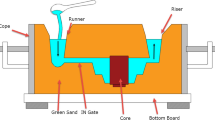Abstract
This paper deals with the application of Six-Sigma methodology to the flywheel casting process in foundry to minimize the defects in this process. The primary tools used in this interventionist process were the process map, cause-and-effect matrix and the failure mode effective analysis. The present study proposes to measure the performance criteria of the process through investigating the effect of working parameters, namely, moisture content, green strength, permeability, and loss on ignition on sand preparation. The experimental results were statistically analyzed and modeled through response surface methodology (RSM). Based on the findings, the optimized process parameters were taken for experiment and better performance obtained in the production process was confirmed. The comparison between the existing process and the proposed process has been attempted in this paper and the results have been discussed in detail.
Similar content being viewed by others
References
Sushil Kumar, Satsangi P.S, Prajapati D.R. (2006) Optimization of green sand casting process parameters of a foundry by using Taguchi’s method. Int J Adv Manuf Technol. doi:10.1007/s00170-010-3029-0.
Sahoo AK, Tiwarib MK, Milehamc AR (2008) Six Sigma based approach to optimize radial forging operation variables. J Mater Process Technol 202:125–136
Chakravorty SS (2009) Six Sigma programs: an implementation model. Int J Prod Econ 119:1–16
Vijayaram TR, Sulaiman S, Hamouda AMS, Ahmad MHM (2006) Foundry quality control aspects and prospects to reduce scrap rework and rejection in metal casting manufacturing industries. J Mater Process Technol 178:39–43
Buch K, Tolentino A (2006) Employee perception of the rewards associated with Six Sigma. J Organ Chang Manag 19(3):356–364
Schon K (2006) Ways of implementing Six Sigma in a non-American culture. Int J Six Sigma Compet Advantage 2(4):404–428
Gowen CR (2002) How to implement Six Sigma for maximum benefit. Six Sigma Forum Mag 1(2):27–31
Henderson KM, Evans JR (2000) Successful implementation of Six Sigma: benchmarking General Electric Company. Benchmarking: An Int J 7(4):260–281
Sokovic M, Pavletic D, Fakin S (2005) Application of Six Sigma methodology for process design quality improvement. In: Proceedings of 13th International Scientific Conference on Achievements in Manufacturing and Materials Engineering, Gliwice, Poland, pp. 611–614
Pavletic D, Fakin S, Sokovic M (2004) Six Sigma in process design, StrojVestn. J Mech Eng 50(3):157–167
Park S.H. (2003) Six Sigma for quality and productivity promotion. ©APO. ISBN: 92-833-1722-X
Goldstein MD (2001) Six Sigma programme. Success Factors Six Sigma Forum Mag 1(1):36–45
Arthur J (2005) Seduce them with success. Qual Prog 38(9):35–40
Allen T.T. (2006) Introduction to engineering statistics and Six Sigma. Springer, London, pp 19–255
Guharaja S, Noorul Haq A, Karuppannan KM (2006) Optimization of green sand parameters using Taguchi method. Int J Adv Manuf Technol 30:1040–1048
Montgomery DC (2001) Design and analysis of experiments, 5th edn. Wiley, New York
Noorul Haq A, Guharaja S, Karuppannan KM (2009) Parameter optimization of CO2 casting process by using Taguchi method. Int J Interact Des Manuf 3:41–50
Montgomery DC (2005) Design and analysis of experiments. Wiley, New York
Shang JS, Li S, Tadikamalla P (2004) Operational design of a supply chain system using the Taguchi method, response surface methodology, simulation, and optimization. Int J Prod Res 42(18):3823–3849
Kumar S, Kumar P, Shan HS (2007) Effect of evaporative pattern casting process parameters on the surface roughness of Al–7 % Si alloy castings. J Mater Process Technol 182:615–623
Taha Ali El-Taweel, Gouda SA. (2011) Performance analysis of wire electrochemical turning process—RSM approach. Int J Adv Manuf Technol. doi:10.1007/j.future00170-010-2809
Palanikumar K (2008) Application of Taguchi and Response Surface Methodologies for surface roughness in machining glass fiber reinforced plastics by PCD tooling. Int J Adv Manuf Technol 36:19–27
Kwak JS (2005) Application of Taguchi and response surface methodologies for geometric error in surface grinding process. Int J Mach Tool Manuf 45:327–334
Montgomery DC (1991) Design and analysis of experiments. Wiley, New York
Antony J (2003) Design of experiments for engineers and scientists. Linacre House, Jordan Hill
Author information
Authors and Affiliations
Corresponding author
Rights and permissions
About this article
Cite this article
Kumaravadivel, A., Natarajan, U. Application of Six-Sigma DMAIC methodology to sand-casting process with response surface methodology. Int J Adv Manuf Technol 69, 1403–1420 (2013). https://doi.org/10.1007/s00170-013-5119-2
Received:
Accepted:
Published:
Issue Date:
DOI: https://doi.org/10.1007/s00170-013-5119-2



